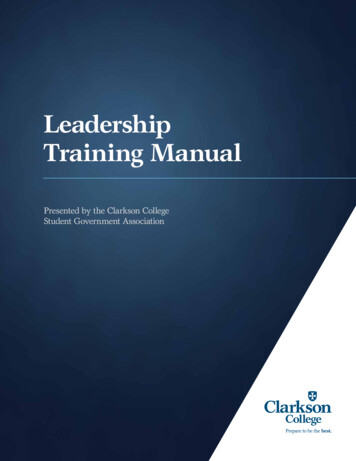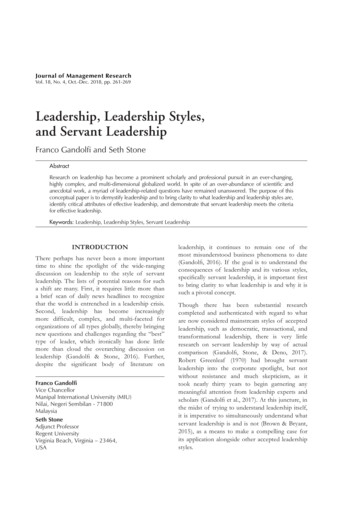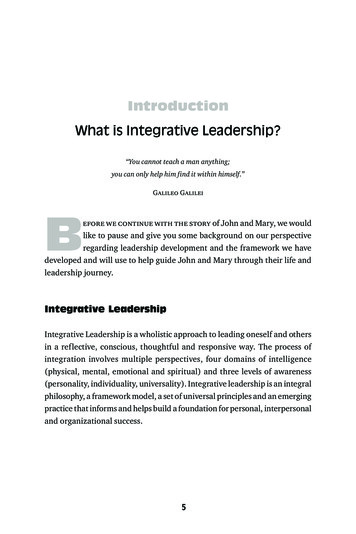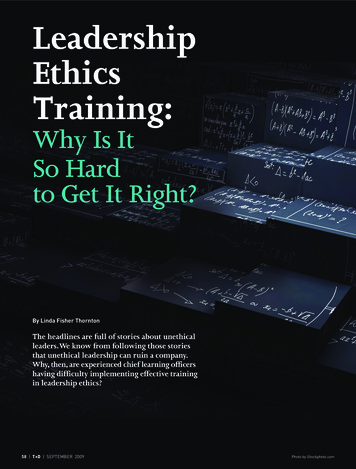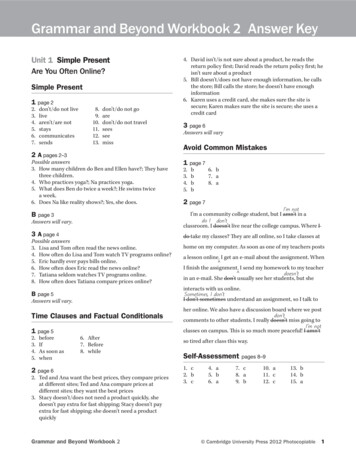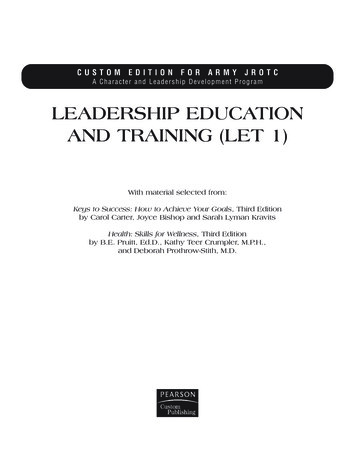
Transcription
CUSTOM EDITION FOR ARMY JROTCA Character and Leadership Development ProgramLEADERSHIP EDUCATIONAND TRAINING (LET 1)With material selected from:Keys to Success: How to Achieve Your Goals, Third Editionby Carol Carter, Joyce Bishop and Sarah Lyman KravitsHealth: Skills for Wellness, Third Editionby B.E. Pruitt, Ed.D., Kathy Teer Crumpler, M.P.H.,and Deborah Prothrow-Stith, M.D.
Cover images courtesy of Army JROTC.Content created by JROTC unless otherwise credited in book from sources listed below.Taken from:Keys to Success: How to Achieve Your Goals, Third Editionby Carol Carter, Joyce Bishop, and Sarah Lyman KravitsCopyright 2001 by Prentice-Hall, Inc.A Pearson Education CompanyUpper Saddle River, New Jersey 07458Health: Skills for Wellness, Third Editionby B.E. (Buzz) Pruitt, Ed.D., Kathy Teer Crumpler, M.P.H., and Deborah Prothrow-Stith, M.D.Copyright 2001 by Prentice-Hall, Inc.Copyright 2005, 2002 by Pearson Custom PublishingAll rights reserved.This copyright covers material written expressly for this volume by the editor/s as well as the compilation itself. It doesnot cover the individual selections herein that first appeared elsewhere. Permission to reprint these has been obtained byPearson Custom Publishing for this edition only. Further reproduction by any means, electronic or mechanical, includingphotocopying and recording, or by any information storage or retrieval system, must be arranged with the individualcopyright holders noted.The term “Thinking Maps” and the term “Thinking Maps” with the graphic forms of the eight Maps have registeredtrademarks. No use of the term “Thinking Maps” with or without the graphic forms of the eight Maps may be used inany way without the permission of Thinking Maps, Inc. For use of Thinking Maps in the classroom, inquiries regardingThinking Maps and training can be made to Thinking Maps, Inc., 1-800-243-9169, www.thinkingmaps.com.Winning Colors is a registered trademark of the Conover Company/Oakwood Solutions, L.L.C.Printed in the United States of America10 9 8 7 6 5 4 3 2 1ISBN 0-536-84717-72004420235DG/JSPlease visit our web site at www.pearsoncustom.comPEARSON CUSTOM PUBLISHING75 Arlington Street, Suite 300, Boston, MA 02116A Pearson Education Company
Brief ContentsUnit1Citizenship in ActionChapter 1 Foundations of Army JROTCand Getting Involved12Unit 2 Leadership Theory andApplication73Chapter 1Being a Leader74Chapter 2Leadership SkillsUnit3Foundations for Success119135Chapter 1Know Yourself—Socrates136Chapter 2Learning to Learn161Chapter 3Study Skills192Chapter 4Communication Skills224
ivBrief ContentsChapter 5Conflict Resolution238Chapter 11 NEFE High School FinancialPlanning Program260Appendix Mandatory Core ServiceLearning263Chapter 8 Making a Difference withService Learning264Index285
Table of ContentsUnit1Citizenship in ActionChapter 1 Foundations of Army JROTCand Getting InvolvedLesson 1 Army JROTC — The Making of aBetter CitizenLesson 2 The Past and Purpose of Army JROTCLesson 3 Moving Up In Army JROTC (Rankand Structure)Lesson 4 The Signs of SuccessLesson 5 Your Personal Appearance and UniformLesson 6 The Stars and StripesLesson 7 Proudly We Sing—The National AnthemLesson 8 American Military Traditions, Customs,and Courtesies1238112839526065Unit 2 Leadership Theory andApplication73Chapter 1Being a Leader74Lesson 1 Leadership Defined75
viTable of ContentsLesson 2Lesson 3Lesson 4Lesson 5Leadership ReshuffledLeadership From The Inside OutPrinciples and LeadershipSexual Harassment/AssaultChapter 2Leadership SkillsLesson 1 Steps from the PastLesson 2 Roles of Leaders and Followers in DrillLesson 3 Using Your Leadership Skills/Taking ChargeUnit3Foundations for SuccessChapter 1818698113119120124131135Know Yourself—Socrates136Lesson 1 Self-AwarenessLesson 2 Appreciating Diversity throughWinning Colors Lesson 3 Personal Growth PlanLesson 4 Becoming an Active Learner137Chapter 2Learning to LearnLesson 1 Brain Structure and FunctionLesson 3 Learning Style and ProcessingPreferencesLesson 4 Multiple IntelligencesChapter 3143148154161162175187Study Skills192Lesson 1 Thinking Maps Lesson 2 Reading For MeaningLesson 3 Study Habits that Work for You193199213
Table of ContentsChapter 4Communication SkillsLesson 1 The Communication ProcessLesson 2 Becoming a Better ListenerChapter 5Conflict ResolutionLesson 1 Finding Solutions: ConflictLesson 2 Finding Solutions: Conflictand BehaviorChapter 11 NEFE High School FinancialPlanning ProgramLesson 1 NEFE Introduction: SettingFinancial Goals224225230238239250260261Appendix Mandatory Core ServiceLearning263Chapter 8 Making a Difference withService Learning264Lesson 1 Orientation to Service LearningLesson 2 Plan and Train for Your ExploratoryProjectLesson 3 Project Reflection and IntegrationIndex265271277285vii
Unit 1Citizenship in Action
Chapter 1Foundations of ArmyJROTC and GettingInvolved
Lesson 1Key rtunitiesuniqueWhat You Will Learn to Do Identify how Army JROTC can impact your futureLinked Core Abilities Take responsibility for your actions and choicesSkills and Knowledge You Will Gain Along the Way Explain the mission of Army JROTC Identify the challenges in the Army JROTC program Identify the opportunities of the Army JROTC program Define the key words contained in this lessonChapter 1Army JROTC — TheMaking of a BetterCitizen
4Chapter 1Foundations of Army JROTC and Getting InvolvedIntroductionKey Note TermsJROTC (JuniorReserve Officers’Training Corps) – aprogram thatteaches high schoolstudents the valuesof good citizenshipwhile giving them anintroduction to theU.S. Army.mission – a specificjob given to a personor group of personsto accomplish.cadet – a high schoolstudent enrolled inthe leadership andcitizenship activitiesthrough JuniorReserve OfficersTraining Corps.unique – being theonly one of its kind.motivate – provide aneed or a purposewhich causes a person to want to dosomething.challenges – toarouse the interest ofone’s actions orefforts; to stimulate;the quality of requiring full use of one’sabilities, energy, andresources; to demandidentification fromsomeone before theyare allowed to enteror pass.opportunities – afavorable or advantageous circumstance orcombination ofcircumstances.This lesson introduces you to the U.S. Army Junior Reserve Officers’ TrainingCorps (JROTC) Program, its mission, and the Leadership Education andTraining (LET) curriculum for this first level of your instruction. Completingthe material in this course requires discipline and hard work, but the rewardis well worth your effort. Through Army JROTC, you are building a foundationthat will last a lifetime.If this is your first adventure into the Army JROTC Program — welcome to theteam! You are among a special group of high school students headed for success.Your participation as a student or cadet in this program shows your willingnessto make the most of your high school education. Whatever your reason for taking this course, every member of Army JROTC is special and brings a differentcultural dimension to the program. We are proud that you elected to be a part ofa unique team — a team of winners!Mission Of Army JROTCThe mission of JROTC is to motivate young people to be better citizens. You arethe focus of Army JROTC’s mission. In fact, you are the whole point of ArmyJROTC — it is devoted to your growth, both as a student and as a person. Thisprogram is a cooperative effort on the part of the Army and the host institutionto give you an opportunity for total development and improve yourself in manyways. JROTC teaches self-discipline, confidence, and pride in a job well done,and it offers you challenges and opportunities to: Sharpen your communication skills Promote and encourage citizenship through participation in communityservice projects Develop your leadership potential Strengthen your self-esteem Improve your physical fitness Provide incentives to live drug-free Promote your graduation from high school and develop a solid foundationfor career developmentSome employers spend millions of dollars training their employees to excel inmany of these same skills and attitudes. By taking the JROTC course, you havean advantage over thousands of other young people who are seeking theirplace in the world.
Lesson 1 Army JROTC—The Making of a Better CitizenCourse DescriptionsThe JROTC course is divided into seven sections, or units. Each unit offers younew opportunities, challenges, and different perspectives from which you cansee yourself and the world around you. Unit 7 is the only optional unit in theJROTC course. Take a quick look at what courses JROTC has to offer.Unit 1: Citizenship in ActionThis unit helps develop new skills you can use in school and throughout yourlife. It engages you in the practice of basic citizenship customs and traditions,and in the exploration of opportunities for non-military and military nationalservice. This introductory unit gives you a greater appreciation of Americansymbols, customs and traditions, and the history and purpose of Army JROTC.An introduction to the Department of Defense and other services presents thedifferences and similarities of each service and their unique roles in the defenseof the nation. It also provides opportunities to learn about major, non-militaryservice organizations.Unit 2: Leadership Theory and ApplicationThis unit teaches you about leadership—how to BE a leader, what you need toKNOW when you are influencing others, and what you DO when you are leading.You will learn about character and values, leadership theories and principles,and human behavior. You will have the opportunity to take the leadershiplessons learned in the classroom to the drill field. Most important, this unit willhelp you build your relationships in your community service projects and yourdaily participation in school, work, and community.Unit 3: Foundations for SuccessUnit 3 is designed to provide young cadets with hands-on experiential learningactivities that will build self-awareness, essential life skills, and the ability to setand achieve goals. Content areas include communication, diversity, study skills,conflict resolution, decision-making, and service learning. These lessons exposecadets to complex content, such as the structure and function of the humanbrain, personality, and learning theory in a simple, easy to understand manner,with ample opportunity for application and practice. This unit focuses on thelife skills necessary to build better citizens for tomorrow.Unit 4: Wellness, Fitness, and First AidUnit 4 provides training for getting started on total fitness, split second emergencies, handling common emergencies, and lifesaving measures. There is alsotraining on substance abuse awareness, intervention, and prevention. By teachingthe value of physical exercise and conditioning, personal hygiene, and properdiet through the Cadet Challenge program, you’ll feel good about yourself —both physically and mentally.5
6Chapter 1Foundations of Army JROTC and Getting InvolvedUnit 5: Geography, Map Skills and EnvironmentalAwarenessThis unit helps cadets develop a global perspective and awareness of environmental issues by engaging you in interactive activities that explore the use ofmaps, map reading, and the sport of orienteering (an outdoor sport using mapsto find one’s way). Beginning lessons provide cadets with a basic overview of theglobe and the continents. Each continent is further explored based on its physicaland human characteristics. Subsequent lessons on maps and map reading provide instruction on the use of the compass and orienteering basics to lay thefoundation for participating in orienteering activities or competitions. The unitconcludes with instruction that assists in enhancing your awareness of environment issues.Unit 6: Citizenship in History and GovernmentUnit 6 builds the basic skills and interest for participation in civic and politicallife. You will actively engage in the We The People curriculum to explore the origins, structure, rights, and responsibilities of the American constitutional government. This unit also introduces you to the You the People process and itsCitizenship Skills. Using these skills and various activities, you will exploreAmerican history from 1776 through the present day. Each history lesson isfocused around the development of citizenship. The chapter also includesadvanced history lessons for juniors and seniors as well as appropriate servicelearning projects.Unit 7: Air Rifle Safety and MarksmanshipThis final and optional unit teaches elements of air rifle safety and marksmanship. The focus is on history, safety, and operation, taking aim, firing techniques,positions, scoring, and firing for record.ConclusionCadet success is the main goal of all Army JROTC learning experiences. Thiscourse focuses on the development of better citizens by building skills in leadership, citizenship, life success, geography, and wellness, in a structured interactive environment. The JROTC program is one of the Army’s contributions to
Lesson 1 Army JROTC—The Making of a Better Citizenassisting America’s youth to become better citizens. It can prepare you for lifeby providing a framework for the qualities (skills, knowledge, and positive attitudes) that will help you to succeed — qualities such as courage, candor, competence, commitment, confidence, and character. JROTC offers manyopportunities for teamwork, advancement, and self-enrichment that are notavailable in other high school courses. The effort you put into mastering thisprogram and developing your personal skills will help you become a successfulstudent and productive adult. Several components of this course have beenevaluated and identified for college credits upon successful completion of thespecified requirements.Lesson Review1. What is the mission of Army JROTC?2. What JROTC skills do you look forward to learning?3. Give an overview of one unit in the JROTC course.4. Define the term “candor.”Key Note Termcandor – impartiality, fairness; frankness, opennessChapter 1 Lesson ReviewBy enrolling in Army JROTC and joining the ranks of millions of other cadets whoknow the meaning of success, you have taken the first step toward a promisingfuture.7
Lesson 2Chapter 1The Past and Purposeof Army JROTCKey Termsconflict resolutionculturally diverseleadershipNational Defense ActWhat You Will Learn to Do Analyze the purpose of the Army JROTC programLinked Core Objectives Apply Critical Thinking TechniquesSkills and Knowledge You Will Gain Along the Way Describe the U.S. congressional act that created JROTC Identify the JROTC program outcomes Explain significant historical events that combined military training and education Define key words contained in this lesson
Lesson 2The Past and Purpose of Army JROTC9Military And Education: Historical ConnectionsJunior ROTC’s (JROTC) mission “To motivate young people to be better citizens,” has changed very little since 1916 when Congress passed the NationalDefense Act; however, the tradition of combining formal education with military studies goes back as far as the ancient Greeks. Centuries before JROTCexisted, the Greeks, Romans, feudal Europeans, and Japanese had their own versions. In the United States, JROTC had its beginnings in Norwich, Vermont.In 1819, Captain Alden Partridge, a former Superintendent of the United StatesMilitary Academy at West Point, founded the American Literary, Scientific, andMilitary Academy in Norwich, Vermont. This academy is now known as NorwichUniversity. Military studies were a major part of the academy’s course work.Captain Partridge felt that if his cadets were not prepared to defend their country’s rights, their education was incomplete.Key Note TermNational DefenseAct – Enacted in 1916,this act officially created the Reserve Officers’ Training Corp ofwhich Junior ROTC isa part.In addition to extensive drill practice and physical training (including marchesof up to 50 miles per day), the cadets studied Latin, Greek, Hebrew, French,English, ten types of mathematics, five types of law, and military history datingback to biblical times.Captain Partridge’s Academy was so successful that the idea of combining military studies with regular classes spread to other schools in the United States.Where Army JROTC IsArmy JROTC is active in more than 1,550 high schools worldwide: in all 50 of theUnited States, the District of Columbia, Asia, Europe, the Caribbean, and otherlocations where the United States has an extended presence.Purpose of JROTCJROTC prepares high school students for responsible leadership roles whilemaking them aware of the benefits of citizenship. Classroom and outside activities, including service learning projects, become opportunities to acquire theknowledge, discipline, and sense of responsibility that are necessary to takecharge of one’s future. The result is responsible cadets who are sure of themselves, can think on their own, and can express their ideas and opinions clearlyand concisely.Desired GoalsLeadership education and training goals are for cadets to: Graduate from high school. Be good citizens by knowing and exercising the rights, responsibilities, privileges, and freedoms of good citizenship.Key Note Termleadership – the ability to influence, lead,or guide others so asto accomplish a mission in the mannerdesired.
10Chapter 1 Gain leadership potential and the ability to live and work cooperatively withothers; demonstrate leadership in situations involving conflict resolution. Achieve positive self-esteem and winning behavioral concepts in a culturallydiverse society. Learn the ability to think logically and to communicate effectively, withemphasis on effective oral communication. Learn the importance of diet and of physical fitness in maintaining good healthand appearance. Gain an understanding of the history, purpose, and structure of Army JROTC. Acquire proficiency in basic military skills (such as drill and ceremonies, firstaid, and map reading) that are necessary for working effectively as a member ofa team. Learn the importance of citizenship through American history as it relates toAmerica’s culture and future from the Revolutionary period to the present. Learn about the dangers of substance abuse and the importance of mentalmanagement, including goal setting and positive self-talk.Key Note Termsconflict resolution –the solutions utilizedby a society to settledisputes in a cohesive manner.culturally diverse –the presence of multiple and differentcultural groups andtheir behaviorswithin an organization or institution.Foundations of Army JROTC and Getting InvolvedChapter 1 Lesson ReviewConclusionJunior ROTC cadets are part of a proud tradition. Similar to their predecessors atCaptain Partridge’s American Literary, Scientific, and Military Academy, today’scadets are learning to lead and to motivate others while preparing to take partin today’s competitive world.Lesson Review1. Where is Army JROTC active?2. What is the purpose of JROTC? Choose one purpose and discuss how it pertainsto you.3. Name two desired goals from leadership education and training.4. Discuss the National Defense Act.
Lesson 3Key uadssubordinatesuccessionteam(s)What You Will Learn to Do Illustrate the rank and structure of Army JROTCLinked Core Abilities Communicate using verbal, non-verbal, visual, and written techniquesSkills and Knowledge You Will Gain Along the Way Identify Army JROTC enlisted and officer insignia Correlate cadet ranks to positions on the JROTC cadet battalion organizationdiagram Correlate duties and responsibilities with positions in an Army JROTC cadetbattalion Evaluate how the organization supports the operation of the Army Define key words contained in this lessonChapter 1Moving Up In ArmyJROTC (Rank andStructure)
12Chapter 1Foundations of Army JROTC and Getting InvolvedIntroductionKey Note Termsenlisted – relating toor constituting thepart of the militaryforce below officers.battalion – a militaryunit made up of twoor more companiesor batteries and aheadquarters that iscommanded by alieutenant colonel, isthe smallest unit tohave a staff, and isadministratively selfsufficient.succession – theorder of persons nextin line for an office orrank that is held byanother.subordinate – aperson lower in rankor grade.team(s) – a group ofpersons approximating one-half of asquad and normallyled by a juniornoncommissionedofficer.Army JROTC has a well-defined structure of organization. Each person in theunit has an individual job that is part of a larger task, which is part of a muchlarger mission. This lesson introduces you to the major concepts of commandwithin the military, it shows you the various U.S. Army and Army JROTCenlisted and officer ranks, and it presents a typical organizational structure for aJROTC cadet battalion.Pyramid of AuthorityThere is a pyramid of authority within most organizations. For JROTC and themilitary, this pyramid of authority, shown in Figure 1.3.1, includes individualand group responsibility. In this lesson, you find out how this pyramid worksalong with the ranks and structure of your Cadet Battalion.From the top to the bottom of this pyramid is a chain of command. The chain ofcommand is a succession of leaders through which authority and commandspass from the leader to subordinate, and then down through the ranks.Chain of CommandAn effective chain of command can guarantee that all members are on the sameteam, working hard to accomplish their individual tasks and those of the unit.A chain of command depends on team members having various duties.Span of ControlSpan of control is the number of immediate subordinates one commander orleader can effectively control, supervise, or direct. Maximum and minimumlimits of control vary with the conditions under which the unit operates andthe complexity of the functions performed.Unity of CommandIn every effective military unit, there must be only one commander who isresponsible for all that the unit does or all that it fails to do. This commandermust have the necessary authority to carry out the responsibilities of the unit.Figure 1.3.1: JROTCPyramid of AuthorityUnity ofCommandSpan ofControlChain ofCommand
Lesson 3Moving Up in Army JROTC (Rank and Structure)13Rank and GradeRank and grade are terms used by the military to classify soldiers. Rank is theactual title held by a soldier; grade is a letter/number combination that meansthe same thing. Soldiers are classified as either enlisted or officers. Figure 1.3.2identifies the rank and grade for soldiers in the U.S. Army.Within the enlisted ranks are two divisions based on experience and skill. The firstthree enlisted positions are usually entry level.Figure 1.3.2: Rank andgrade for U. S. Armysoldiers.
14Key Note Termspecialists – a personwho devotes himselfto a particular occupation or field ofstudy; the enlistedrank in the Armycorresponding to acorporal.Chapter 1Foundations of Army JROTC and Getting InvolvedNotePersonnel designated as specialists are comparable to the noncommissioned officerrank of corporal, and are commonly referred to as technicians. They are not placedin command of other enlisted personnel.Noncommissioned officers are those personnel who have advanced above thefirst three entry level positions and are in a supervisory position over personnelin lower grades.Commissioned officers are appointed by the President and confirmed by theSenate. Commissioned officers have authority over lower ranking officers, warrant officers, and enlisted personnel. Warrant officers rank between an enlistedperson and a second lieutenant and primarily hold positions as technicians oradministrative supervisors.Advancement to higher ranks and grades is based on ability, skill, experience,and potential.Key Note Termcompany – a subdivision of a military regiment or battalionthat constitutes thelowest administrativeunit. It is usuallyunder the commandof a captain and ismade up of at leasttwo platoons.platoons – a subdivision of a companysize military unitnormally consistingof two or moresquads or sections;the leader is usually afirst lieutenant.squads – the smallestunit in the Armyorganization composed of a varyingnumber of personnel,depending on thetype of element, andled by a noncommissioned officer.A similar structure exists for cadet officers and noncommissioned officers in theArmy JROTC Program. The insignia of grade for cadet officers and noncommissioned officers is shown in Figure 1.3.3. The grade of warrant officer does not existin Army JROTC. The chart on the next page illustrates a model cadet battalionorganizational structure that establishes a clearly defined chain of command andpyramid of authority — much the same as in the Army. A similar organizationexists within your own cadet battalion.The Cadet Battalion Commander reports to the Army instructors and to theprincipal. All other officers and noncommissioned officers report to the CadetBattalion Commander through the chain of command.Each company consists of a headquarters section and at least two platoons.The company headquarters contains the following key personnel: Company Commander Company Executive Officer Company First Sergeant Guidon BearerEach platoon is composed of a headquarters section and at least two or threesquads, with two teams per squad. The key platoon personnel are as follows: Platoon Leader Platoon Sergeant Two or three Squad Leaders Two or three Assistant Squad Leaders (if the number of enrolled cadets permits) Four to six team leaders
Lesson 3Moving Up in Army JROTC (Rank and Structure)Figure 1.3.3: Insignia of grade for cadet officers.Duties and ResponsibilitiesThis section provides an outline of the duties and responsibilities for the personnel in a model cadet battalion organization. Your cadet battalion may contain additional positions or list duties and responsibilities different from these;however, the JROTC instructor staff will determine the exact positions andduties for your organization. Cadet leaders are expected to become familiarwith their own duties and responsibilities as well as those of their superiors andsubordinates.15
16Chapter 1Foundations of Army JROTC and Getting InvolvedBattalion ssistantsBattalionCommandSergeant MajorS-3OperationsS-4LogisticsAssistantsA tantsOtherCompaniesB Company1st Platoon2nd Platoon1st Platoon2nd PlatoonSquadSquadSquadSquadFigure 1.3.4: Battalion organization.Use the following duties and responsibilities as a guide only. As you can see byFigure 1.3.4, a model cadet battalion organization has a clearly defined chain ofcommand.A. Command PositionsThe Army command positions are Battalion Commander and Company Commander. These positions are covered in the following sections.1. Battalion Commander (Cadet Lieutenant Colonel)This position is the most demanding in a cadet battalion. The instructor staffselects the cadet for this position based on demonstrated leadership ability andacademic standing. The appointed cadet must be able to apply common senseand judgment in the solving of problems that affect the entire cadet corps.Specific chain of command is shown in Figure 1.3.5.
Lesson 3Moving Up in Army JROTC (Rank and Structure)Figure 1.3.5: Battalioncommander command.BATTALIONCOMMANDERBATTALIONEXECUTIVE OFFICERS-1S-2S-3COMPANY ACOMMANDERS-4BATTALION COMMANDSERGEANT MAJORS-5COMPANY BCOMMANDERCOMPANY CCOMMANDERThe battalion commander must be mature, willing to accept responsibility, andable to effectively delegate authority and supervise subordinates. The battalioncommander controls the staff through the battalion executive officer and thecompanies through the company commanders, while maintaining the finalapproval authority in the cadet chain of command.The specific duties of the battalion commander are to:(a) Command the battalion at all formations.(b) Prepare for and conduct the training of the battalion on drill days.(c) Maintain a direct and personal relationship with the staff and the companycommanders.(d) Encourage the company commanders to communicate freely.(e) Use the staff to assist in gathering information and preparing plans for conducting training and controlling the battalion.(f ) Designate staff officers to assist in the preparation, execution, and supervision of orders.(g) Ensure that feelings of mutual respect and confidence exist between the staffand company commanders.(h) Ensure that staff members are capable and that they understand theirresponsibilities to the battalion commander, battalion executive officer, andto the corps of cadets.(i) Ensure orders and actions are in compliance with JROTC regulations, policies, and directives and with local school regulations and policies.(j) Execute all responsibilities in the name of the Senior Army Instructor; seekadvice and assistance from the instructor staff and carry out all of their directives quickly and completely.(k) Arrange the required meetings and assemble the required command or staffpersonnel to determine any actions that may be necessary in fulfilling theobligations of the cadet battalion.(l) Be prepared to evaluate any member of the battalion, but specifically thebattalion headquarters personnel and the company commanders.(m) Make operational decisions for the cadet battalion.17
18Chapter 1Foundations of Army JROTC and Getting Involved(n) Preside over officer calls.(o) Work with school authorities in coordinating activities of the cadet battalionwith the organizations of the school, ensuring that battalion activities are inaccordance with school policy.(p) In coordination with the Senior Army Instructor, assign missions to allextracurricular team captains such as drill, rifle, color guar
Mission Of Army JROTC The mission of JROTC is to motivate young people to be better citizens. You are the focus of Army JROTC's mission. In fact, you are the whole point of Army JROTC — it is devoted to your growth, both as a student and as a person. This program is a cooperative effort on the part of the Army and the host institution

